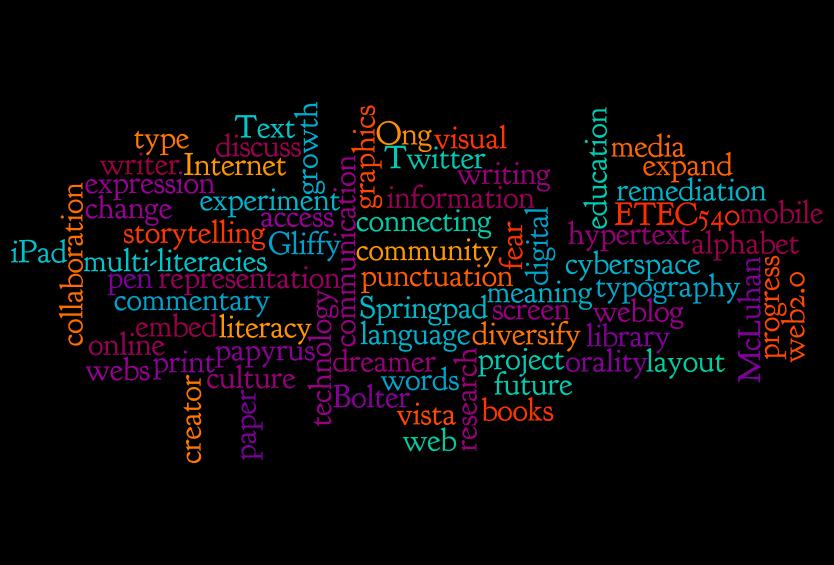In this post, I’m going to summarize the topics we covered in the course, going by module and referring to other posts on this blog.
Module 1: Introductions and Defining Terms
We started off by explaining what the terms text and technology meant to us. Kym Francis defines text as a variety of communication media that are perceived by reading or viewing. I would add “feeling” to include braille and to represent all forms of perception by those with developmental disabilities. Kym goes on to say that technology consists of any tool that is used in the creative process for making text.
We continued the module by discussing the costs and benefits of new technologies on literacy and education in general. In the past, pencils were seen as a threat to learning, and more recently smart phones were too. They are not fully accepted in schools, but the opportunities they provide in terms of mobile learning certainly make them appealing educational tools. Who knows what will be the next threat-turned-necessity in education?
Module 2: From Orality to Literacy
In the second module, we discussed the changes that occur when a society goes from speech-based to text-based communication. According to the class orality is characterized by rote learning, the use of memory aids, and a sense of community because the audience and speaker interact. Orality is also considered as being “in the moment” since stories change with time to be understood by contemporary society. In contrast, literate cultures are considered somewhat inflexible since printed documents may still have an impact on society when their contents are no longer relevant. Literacy is said to help sharpen analysis by allowing for a great amount of material to be studied at a time, rather than relying on the brain’s working memory, which is of very limited capacity.
Kyle Stooshnov described an interesting time in London when society was in the middle of the transition from being illiterate to literate and it was possible to learn both from books and plays. Cultural activities may have been more valued back then than today since they provided not only entertainment, but also educational value.
Module 3: Discovering Modern Literacy
In module 3, we saw that text evolved from the papyrus scroll to the codex to the modern book. This evolution is decribed in great detail by The Electronic Labyrinth.
Cecilia Sun commented on Bolter’s (2001) take on modern literacy by describing the relationship of culture and technology over time. Society’s desire for knowledge is a driving force for the development of technology and texts in formats of increasingly higher quality. As text-related technology improves, people find new ways of writing and thinking.
Sheila demonstrated the impact of text by focusing on the printing press and its impact on the unprecedented growth in knowledge sharing among the scientific community. What could better facilitate communication and learning among scientists of the Renaissance than the rapid distribution of multiple copies of books… besides acceptance of their findings by the Church?
Module 4: Literacy and the New Media
Having seen, in the previous modules, how changes in technology affect society and literacy, it was now time to move on to digital texts. We discussed word processing, multimodal learning and hypertext, among other topics.We created a definition of digital literacy, indicating the communication options it provides, such as real-time chat discussions and bulletin boards. We also pointed out that digital texts consist of rich content in a variety of formats forcing changes in literacy pedagogy. Digital literacy education would have to nurture the development of critical thinking so that students appropriately use information found on the Web.
Ken Stackhouse commented on this very topic by indicating that ever-changing technologies are really just providing extensions of existing methods of communication. He also addressed the need to teach multiliteracy skills using situated practice so that students can become more aware of and more engaged in current events.
This module concluded with reading two chapters from Bolter (2001). He discussed the relationship between writing and the mind. New technologies provide access to vast amounts of information and increasingly complex ways of processing it. Further, they allow people from around the world to create new realities together and shape their ways of thinking when participating in communal online activities. Bolter also discussed how technology changes the way people create and organize information. In turn, the values, power structures and knowledge of society change. Acknowledging the power of technology will be important for dealing with inevitable changes in access to information in the future.
Reference
Bolter, J. D. (2011). Writing space: Computers, hypertext, and the remediation of print. New York, NY: Routledge



